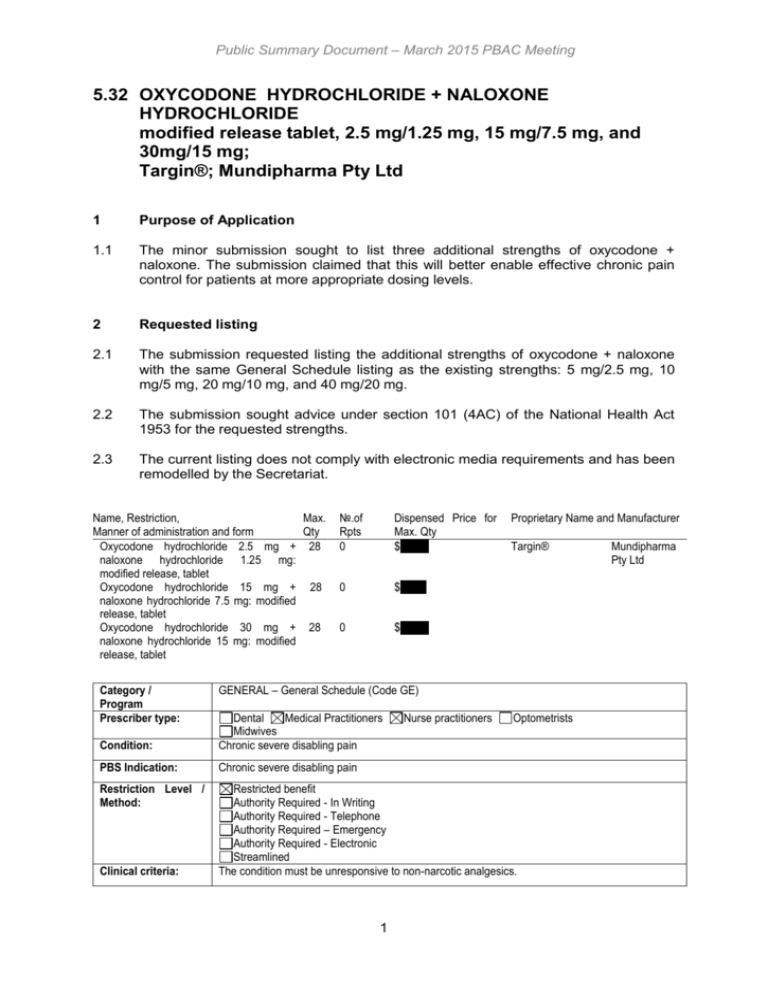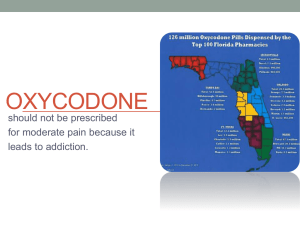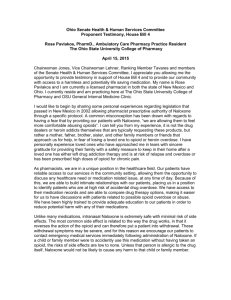(PSD) March 2015 PBAC Meeting
advertisement

Public Summary Document – March 2015 PBAC Meeting 5.32 OXYCODONE HYDROCHLORIDE + NALOXONE HYDROCHLORIDE modified release tablet, 2.5 mg/1.25 mg, 15 mg/7.5 mg, and 30mg/15 mg; Targin®; Mundipharma Pty Ltd 1 Purpose of Application 1.1 The minor submission sought to list three additional strengths of oxycodone + naloxone. The submission claimed that this will better enable effective chronic pain control for patients at more appropriate dosing levels. 2 Requested listing 2.1 The submission requested listing the additional strengths of oxycodone + naloxone with the same General Schedule listing as the existing strengths: 5 mg/2.5 mg, 10 mg/5 mg, 20 mg/10 mg, and 40 mg/20 mg. 2.2 The submission sought advice under section 101 (4AC) of the National Health Act 1953 for the requested strengths. 2.3 The current listing does not comply with electronic media requirements and has been remodelled by the Secretariat. Name, Restriction, Manner of administration and form Oxycodone hydrochloride 2.5 mg + naloxone hydrochloride 1.25 mg: modified release, tablet Oxycodone hydrochloride 15 mg + naloxone hydrochloride 7.5 mg: modified release, tablet Oxycodone hydrochloride 30 mg + naloxone hydrochloride 15 mg: modified release, tablet Category / Program Prescriber type: Max. Qty 28 №.of Rpts 0 Dispensed Price for Max. Qty $'''''''''''''' 28 0 $''''''''''''' 28 0 $'''''''''''''' Proprietary Name and Manufacturer Targin® GENERAL – General Schedule (Code GE) Condition: Dental Medical Practitioners Midwives Chronic severe disabling pain PBS Indication: Chronic severe disabling pain Restriction Level / Method: Restricted benefit Authority Required - In Writing Authority Required - Telephone Authority Required – Emergency Authority Required - Electronic Streamlined The condition must be unresponsive to non-narcotic analgesics. Clinical criteria: 1 Nurse practitioners Optometrists Mundipharma Pty Ltd Public Summary Document – March 2015 PBAC Meeting Administrative Advice Note Authorities for increased maximum quantities and/or repeats will be granted only for: (i) chronic severe disabling pain associated with proven malignant neoplasia; or (ii) chronic severe disabling pain not responding to non-narcotic analgesics where the total duration of narcotic analgesic treatment is less than 12 months; or (iii) first application for treatment beyond 12 months of chronic severe disabling pain not responding to non-narcotic analgesics where the patient's pain management has been reviewed through consultation by the patient with another medical practitioner, and the clinical need for continuing narcotic analgesic treatment has been confirmed. The date of the consultation must be no more than 3 months prior to the application for a PBS authority. The full name of the medical practitioner consulted and the date of consultation are to be provided at the time of application; or (iv) subsequent application for treatment of chronic severe disabling pain not responding to nonnarcotic analgesics where a PBS authority prescription for treatment beyond 12 months has previously been issued for this patient. Cautions Note Shared care model: For prescribing by nurse practitioners where care of a patient is shared between a nurse practitioner and medical practitioner in a formalised arrangement with an agreed management plan. Further information can be found in the Explanatory Notes for Nurse Practitioners. The risk of drug dependence is high. 2.4 Expert clinicians have advised that “narcotic” is an outdated term that has been replaced with “opioid” in clinical practice. 3 Background 3.1 The currently listed oxycodone + naloxone strengths were TGA approved in March 2010 for the management of moderate to severe chronic pain unresponsive to nonnarcotic analgesia. The naloxone component is indicated for the therapy and/or prophylaxis of opioid-induced constipation. The requested strengths were TGA registered in September 2014. 3.2 The currently listed oxycodone + naloxone strengths were recommended for PBS listing at the November 2010 PBAC meeting for the treatment of chronic severe disabling pain. The requested strengths have not previously been considered by the PBAC. 3.3 At its November 2014 meeting the PBAC noted that use of opioids, particularly oxycodone and paracetamol + codeine, is drastically increasing. The PBAC advised the Minister that a systematic approach should be undertaken to review and target the use of these opioids to promote the Quality Use of Medicines. 3.4 The PBAC previously considered the issues of opioid subsidy at various times, including at a stakeholder meeting in 2011 and at the August special PBAC meeting in 2012. 2 Public Summary Document – March 2015 PBAC Meeting 4 Clinical place for the proposed therapy 4.1 The submission stated that the introduction of three additional strengths was to allow for improved individual dose titration of oxycodone + naloxone, which would avoid unnecessary side effects whilst allowing patients to obtain maximum analgesic benefits. The submission also contended that it would simplify therapy in terms of safety and compliance. 4.2 The submission contended that medical practitioners prefer to initiate new patients on oxycodone + naloxone rather than switching from oxycodone once a patient achieves effective pain control. The submission argued that this is further evidence that lower doses of oxycodone + naloxone are necessary to provide the low dose required for initiation. For more detail on PBAC’s view, see section 7 “PBAC outcome” 5 Comparator 5.1 The submission did not nominate a comparator. 6 Consideration of the evidence Hearing 6.1 There was no hearing for this item as it was a minor submission. Consumer comments 6.2 The PBAC noted that no consumer comments were received for this item. Economic analysis 6.3 The price proposed for the new strengths was partially calculated using the Pricing Manual pricing derivation approach. The methodology outlines that a half strength presentation would be priced at 70% of the double strength. This was applied to the 2.5 mg/1.25 mg strength, which is half that of the existing 5 mg/2.5 mg presentation. As this methodology could not be used for the 30 mg/15 mg preparation it was instead priced at the midpoint between the 20 mg/10 mg and 40 mg/20 mg preparations. The 30 mg/15 mg price was then also used as to calculate the 15 mg/7.5 mg price using the 70% methodology. Product Ex-manufacturer price Oxycodone 2.5 mg + naloxone 1.25 mg proposed price Oxycodone 5 mg + naloxone 2.5mg Oxycodone 10 mg + naloxone 5 mg Oxycodone 15 mg + naloxone 7.5 mg proposed price Oxycodone 20 mg + naloxone 10 mg Oxycodone 30 mg + naloxone 15 mg proposed price Oxycodone 40 mg + naloxone 20 mg $'''''''''''''' $'''''''''''' (At February 2014) $''''''''''''' (At February 2014) $'''''''''''''' $''''''''''''''' (At February 2014) $'''''''''''''' $'''''''''''''' (At February 2014) 3 Public Summary Document – March 2015 PBAC Meeting 6.4 It appeared that the above methodology resulted in a price for the new strengths that favoured the submission. The graph below illustrated that of the currently listed strengths of oxycodone + naloxone, the cost per milligram price of the oxycodone component for the 5 mg strength has a proportionally higher price than the other three strengths. Estimated PBS usage & financial implications 6.5 The submission uses a market share approach to estimate the utilisation and cost of the additional strengths using a linear extrapolation over a five year time horizon. Cost to PBS Cost – without new presentations Cost – with new presentations Net Cost Year 1 $'''''''''''''''''''''''''' Year 2 $'''''''''''''''''''''''''' Year 3 $''''''''''''''''''''''''' Year 4 $'''''''''''''''''''''''''''' Year 5 $'''''''''''''''''''''''''''' $'''''''''''''''''''''''''' $''''''''''''''''''''''''' $'''''''''''''''''''''''''''' $'''''''''''''''''''''''' $''''''''''''''''''''''''''' -$'''''''''''''' -$''''''''''''''''' -$''''''''''''''''''''' -$''''''''''''''''''' -$''''''''''''''''''''' 4 Public Summary Document – March 2015 PBAC Meeting Cost to RPBS Cost – without new presentations Cost – with new presentations Net Cost Year 1 $''''''''''''''''''''''' Year 2 $''''''''''''''''''''''''' Year 3 $''''''''''''''''''''''' Year 4 $''''''''''''''''''''''' Year 5 $''''''''''''''''''''''' $'''''''''''''''''''''''''' $'''''''''''''''''''''''' $'''''''''''''''''''''' $''''''''''''''''''''''' $''''''''''''''''''''' -$'''''''''''' -$''''''''''''''' -$''''''''''''''' -$''''''''''''''' -$'''''''''''''''''' 6.6 At year 5, the estimated total number of scripts (for the new strengths) was over 200,000 and the net saving to the PBS was estimated to be less than $10 million per year. 6.7 The submission assumed that listing of the new strengths would reduce the rate of growth in the next higher strength, and that the market share of the lower strengths would increase over time due to patient initiation on lower doses. The submission anticipated that there would be no net change in the number of prescriptions for oxycodone + naloxone due to the assumed offset of new strengths by the reduction in higher strengths. It appeared that the savings calculated were driven by assumption that the lower, cheaper strengths will displace the higher, more costly strengths. 6.8 The submission assumed that the 5 mg strength would achieve 100% market penetration as there is currently no 5 mg oxycodone on the PBS. For more detail on PBAC’s view, see section 7 “PBAC outcome” 7 PBAC Outcome 7.1 The PBAC deferred making a recommendation regarding the proposed listing of additional oxycodone + naloxone strengths. 7.2 The PBAC noted the submission’s assertion that lower doses of oxycodone + naloxone are necessary to provide the low dose required for initiation and considered that this was unlikely to occur in clinical practice. 7.3 The PBAC noted that this sponsor’s 5mg presentation of oxycodone had been removed from the PBS at the request of the sponsor. The PBAC recalled that as a standard part of a request to delist a product from the PBS, it must be established that there is no pressing clinical need for the product in question. Having been satisfied that this was the case for oxycodone 5mg, the PBAC questioned whether there is a clinical need for the lowest proposed strength of oxycodone + naloxone (2.5mg/1.25mg). 7.4 The PBAC considered that further advice would need to be sought regarding the clinical place for additional oxycodone + naloxone strengths, and recommended wider consultation with organisations representing physicians experienced in pain management. 7.5 The PBAC noted expert clinician advice that “narcotic” is an outdated term that has been replaced with “opioid” in clinical practice, and accepted that the clinical criteria “The condition must be unresponsive to non-narcotic analgesics” for currently listed 5 Public Summary Document – March 2015 PBAC Meeting opioids be changed to “The condition must be unresponsive to non-opioid analgesics”. The PBAC noted that this change would impact a significant number of listings and the timing of implementing the change would need to be prioritised. 7.6 The PBAC noted that this submission is not eligible for an Independent Review. Outcome: Deferred 8 Context for Decision The PBAC helps decide whether and, if so, how medicines should be subsidised in Australia. It considers submissions in this context. A PBAC decision not to recommend listing or not to recommend changing a listing does not represent a final PBAC view about the merits of the medicine. A company can resubmit to the PBAC or seek independent review of the PBAC decision. 9 Sponsor’s Comment The sponsor had no comment. 6






